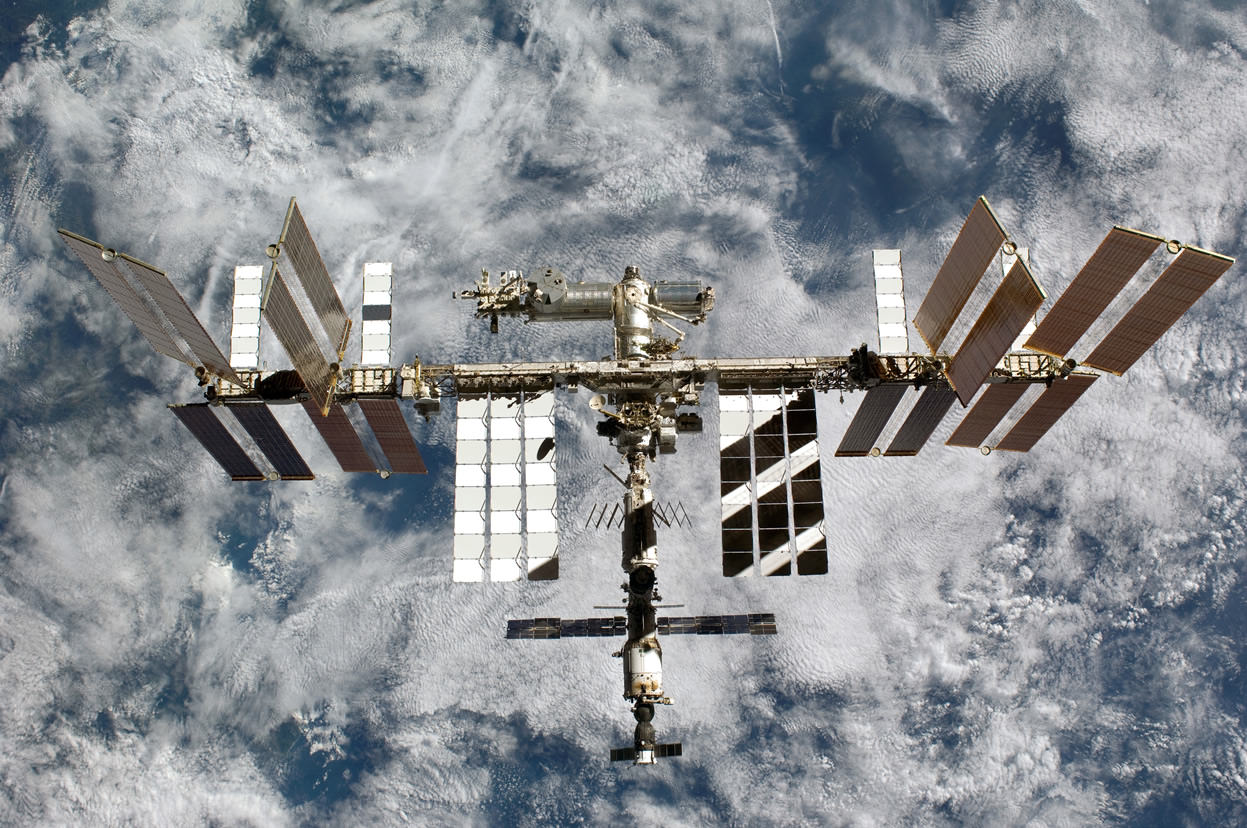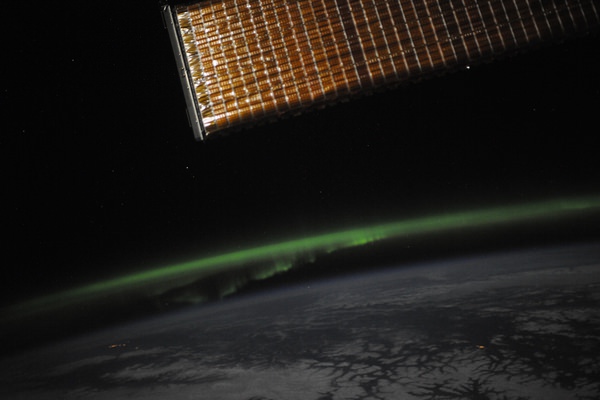ISS Commander Scott Kelly, twin brother of astronaut Mark Kelly, spoke with various news agencies this morning about the shooting of his sister in-law, Rep. Gabrielle Giffords. Kelly was asked several times about the emotional trauma, etc., of the shooting and how he is coping. Scott Kelly confirmed he talks to his brother a couple of times a day, but that is not unusual. Asked about what words the two brothers share about Giffords’ current condition, the ISS Commander said, “We’re not touchy, feely kind of people, … we just talk about her condition, but we normally talk about things like we do regularly.” And later, Kelly was asked if he would like to be there at his brother’s side. “I’m kind of a realist,” he said. “I understand this is the situation I’m in. I would prefer to be there to support everyone, but the fact is that I can’t, even if it was a tragedy worse than this, there is no way I’m coming back to Earth before March 18. We know that going into a flight like this. I just continue to do my job and support my brother and family through the means we have through the station.”
International Space Station on the Moon?

[/caption]
From our vantage point on Earth, it takes just a half second for the International Space Station to fly across the face of the Moon, so catching a transit is tricky. But award-winning French astrophotographer Theirry Legault captured an amazingly sharp and detailed transit image that makes the ISS look like it is sitting on the Moon’s surface! Legault took this image from Avranches (Normandy, France) a few hours before the eclipse, on December 20th at 21:34 UT. He used a Meade 10″ ACF on Takahashi EM400, with a Canon 5D mark II. The transit duration was just 0.55 seconds, as the ISS is traveling at 7.5km/s or 28,0000 km/h (17,500 mph). See below for a close-up crop of the image which shows the amount of detail visible of the space station.
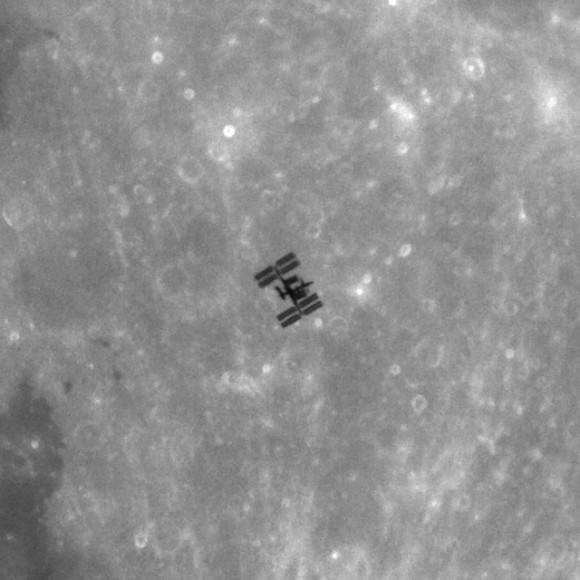
Legault has also taken incredible images of the ISS and a docked space shuttle transiting the Sun, (at least twice), as well as the shuttle Atlantis and Hubble transiting old Sol.
See more of his images at his website, or click the images for larger versions. Legault told us he’ll be traveling for a good view of the solar eclipse on January 4, so we look forward to his images of that event.
Do the #ISSWave All the Way Around the World
C’mon, admit it. If you regularly watch for the International Space Station passing overhead you’ve probably waved or shouted a greeting as it sailed high above you. I regularly salute the ISS, even though I know the astronauts on board can’t see or hear me. But still.
Well, it turns out I’m not alone. Through Twitter, other people have found out that it is pretty common for people to wave at the ISS. So now, as a “celebration of human solidarity during the holiday season” a group of Twitters have organized “ISSWave.” For one week beginning Friday, December 24 through December 31, humans around the world can wave together and show their solidarity with their fellow humans in space (and on Earth) by waving at the ISS as she passes overhead at 28,000 kph (17,500 mph).
You can share your waves on Twitter — either alone or as part of an ISSwave tweetup (a physical gathering of twitterers, or tweeps) — by tweeting your zip/postal code and the hashtag “#ISSwave” along with photos and videos of their waves, thoughts, holiday wishes for the astronauts and cosmonauts, etc. Participants’ waves will be registered in real-time at www.isswave.org.
Astronauts and cosmonauts aboard the International Space Station may even film themselves waving back at ISSwave participants. At least two astronauts, including Ron Garan, have voiced their support for ISSwave in emails and tweets.
How did this idea come about? Well, the organizers are Lucy Rogers (@DrLucyRogers), Richard P. Grant (@rpg7twit) and Karen James (@kejames). The idea for the wave emerged through a serendipitous twitter exchange among the three, and they discovered that watching ISS passes is even more exciting when done together with other humans, whether they are standing right next to you or watching from afar. To know that you are not the only one looking up in awe at this spectacle of human ingenuity and cooperation speeding across the night sky creates a special connection between us.
“The first time I watched an ISS pass I was surprised by how much it affected me,” said Karen James. “‘We made that’, I thought, ‘there are humans up there!’ All of my worries just seemed so tiny in the face of this symbol of human achievement and cooperation. I want to share that experience with other humans and also show my support to the ones living and working aboard the station.”
‘“I’d always wave up at the ISS if I saw it pass overhead,” said Lucy Rogers. “Someone laughed and said the astronauts wouldn’t see me.” So she asked on Twitter if anyone else waved – a lot of people did – and the communal ISS waving began. “When Karen moved to the USA she saw the ISS at a different time to us in Europe – which prompted the idea of a round-the-world wave,” she says.
We see the ISS because it is lit by the Sun. Sunlight reflects off it’s solar panels in the same way it glints off windows here on Earth. As the ISS travels round the world, the reflection can be seen in a broad sweep across the Earth. Due to the angles involved between the Sun, ISS and our location on Earth, sometimes we see bright, high passes and sometimes we can’t see it at all. During the week 24th – 31st December, most places on the Earth should get a good view of it at some point.
The three formed the Twitter account @ISSwave to coordinate, promote and provide updates on the event. Their hope is that seasoned and novice ISS watchers alike will experience the startlingly emotional experience of an ISS pass, amplified by solidarity with thousands of others watching around the world.
They also have a website, where you can find out how to see the ISS in your location, as well as find more info about joining the #ISSWave.
The team hopes the buzz around ISSwave will persuade those who have never watched an ISS pass to participate, marking an increase in awareness about the International Space Station and the existence of a community of space enthusiasts on Twitter (“spacetweeps”).
The wave also celebrates the 10th anniversary of continuous human presence in space with the ISS, which occurred on November 2, 2010 and the 50th anniversary of Yuri Gagarin’s flight into space — the first human spaceflight — on April 12th 2011 (www.YuriGagarin50.org).
Spectacular Night Launch for Soyuz Crew
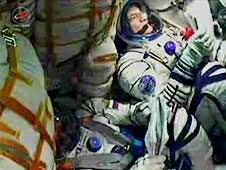
With a spectacular night launch, the remainder of the Expedition 26 crew are now headed to the International Space Station on board a Soyuz TMA-20 spacecraft. NASA astronaut Cady Coleman, Russian cosmonaut Dmitry Kondratyev, and European Space Agency astronaut Paolo Nespoli lifted off from the Baikonur Cosmodrome in Kazakhstan at 2:09 p.m. EST Wednesday (1909 UTC and 1:09 a.m. local in Kazakhstan) on Wednesday, Dec. 16. Video from inside the capsule showed the crew riding comfortably during their ascent.
The trio are scheduled to dock to the station’s Rassvet docking port at 3:12 p.m EST onFriday, Dec. 17. Just in time for the holidays, they will join Expedition 26 Commander Scott Kelly and Flight Engineers Alexander Kaleri and Oleg Skripochka, already on board the ISS.
[/caption]
You can watch the docking on NASA TV, beginning at 2:30 p.m. EST Coverage of the hatches opening and a welcoming ceremony aboard the station will begin at 5:30 p.m.
With a full compliment of six, Expedition 26 will be busy with scientific research and regular maintenance, but there will also be two Russian-segment spacewalks, and a variety of visiting resupply ships: a Japanese HTV cargo ship will arrive at the end of January, a Russian Progress re-supply ship will also come just before, hopefully, space shuttle Discovery arrives in early February — given the repairs of the external tank go well, and then a European Automated Transfer Vehicle, or ATV, arrives at the end of February.
After that, The shuttle Endeavour is scheduled launch in early April along with another Progress later that month.
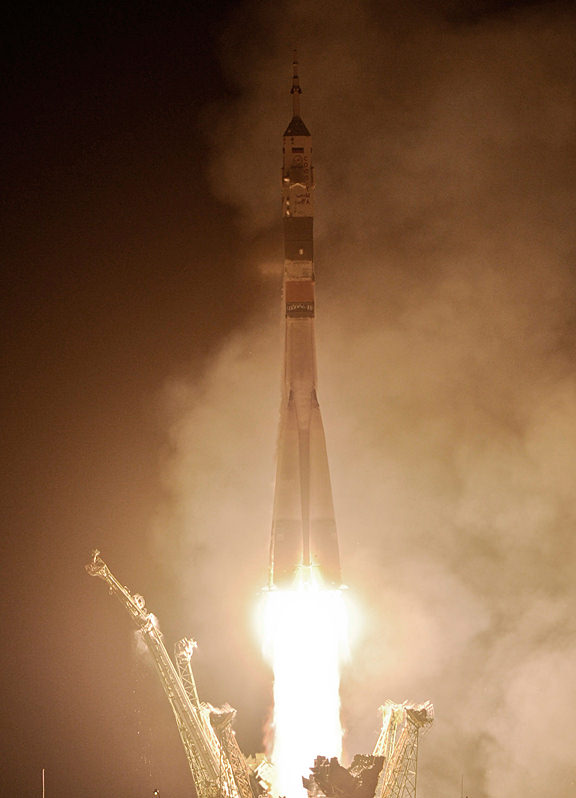
How To Dispose of a Space Station
[/caption]
With the life of the International Space Station extended to at least 2020, we don’t have to think about its demise for awhile. But actually, NASA and the international partners do have to think about and plan ahead for how this huge 400-ton structure in space will one day be deorbited and disposed of. Friend and venerable space writer Leonard David has written an article about how NASA is starting to consider how they will organize and execute “dumping the huge facility into select, but remote, ocean waters in one fell swoop.” It ain’t gonna be easy, and that’s why thorough planning is a must. It might take a combination of vehicles (ESA’s ATV, Russian Progess) to send the ISS on a very safe and precise swan dive. Or, another possibility is that some of the modules could be re-used elsewhere.
Grand Tour of Closet-Sized Crew Quarters in Space
Who knew it could take almost seven minutes to get a tour of the teeny-tiny crew quarters on board the International Space Station? But Expedition 26 Commander Scott Kelly provides an engaging peek inside his personal living space, and an inside look at life aboard the ISS.
Breathtaking Recent Aurora Images from Earth and Space
[/caption]
With the Sun’s activity increasing just a bit, sky watchers have witnessed an uptick in aurorae, especially northern observers. This top image is from an *extreme* northern observer, as in way up; about 320 km (220 miles) up above the Earth. Astronaut Doug Wheelock took this image from the International Space Station, and the beautiful sight made him wax poetic:
“Aurora Borealis as I will forever paint it in my dreams,” he wrote on Twitter. “Almost time to return home… no regrets… but mixed emotions. Leonardo da Vinci was right… ‘For once you have tasted flight, you will forever walk the Earth with your eyes turned skyward, for there you have been… and there you will long to return.'”
See other stunning recent aurora images from a more Earthly viewpoint:
These particular aurorae sightings were likely the result of a solar flare that erupted towards Earth on Nov. 12.
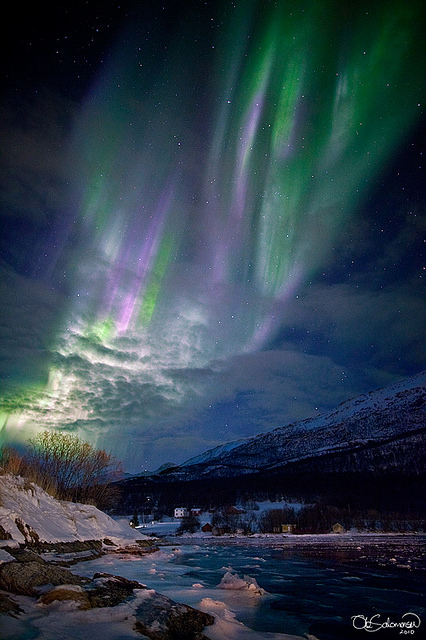
Describing this picture, Salomonsen said on Flickr: “With a CME expected to hit earth on Nov.14th we could still see only a faint aurora. We got frustrated and then decided to drive back towards the city where it now was reported to clear up. After 5 minutes in the car suddenly we could see a strong aurora bursting out behind the partially cloudy sky.”
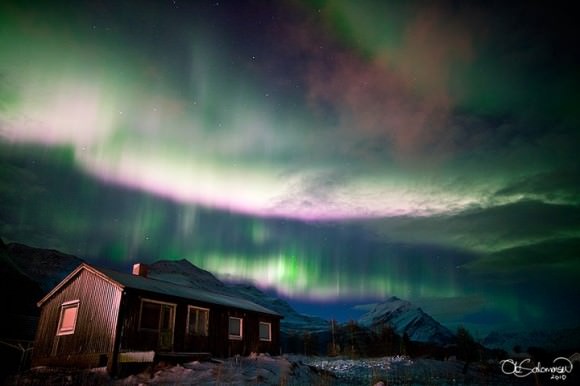
This is another gorgeous shot by Salomonsen, and on his Flickr site, he points out Ursa Major is visible in the top left, said it was just amazing how there were two rays of white and purple aurora, one moving faster than the other.
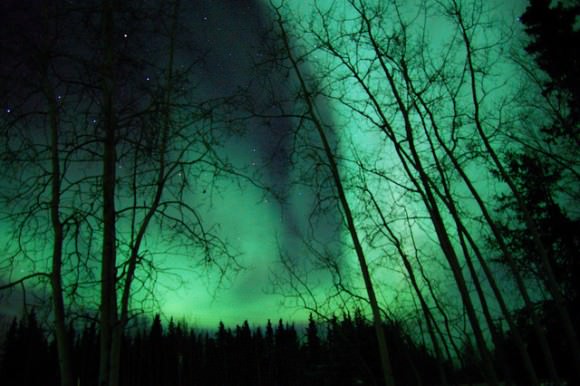
Photographer Sean Davies took this image on Nov. 13, 2010 near Dettah in the Northwest Territories, Canada, and said, “The aurora put on a great show just outside Yellowknife. The show lasted a good hour.” There’s another from Sean, below, on the same night. You can see more of Sean’s images at his Flickr site.
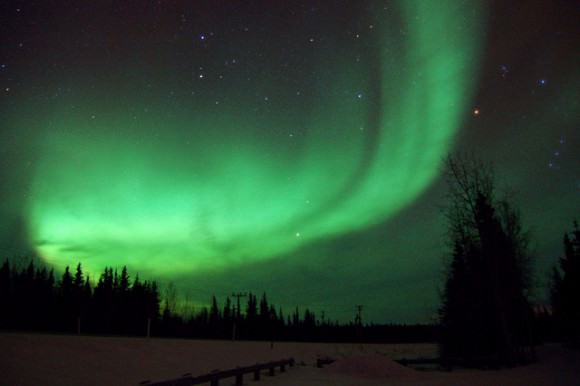
The photo below was taken on November 13, 2010 in Auster-Skaftafellssysla, Iceland by Skarphéðinn Þráinsson. See more of his images at Flickr.
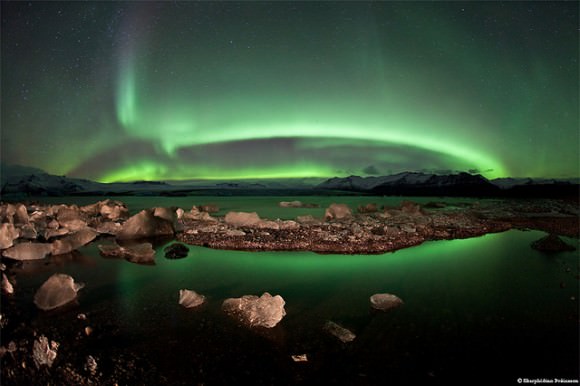
This timelapse video was taken by Tor Even Mathisen, also from Tromsø, Norway.
Aurora Borealis timelapse HD – Tromsø 2010 from Tor Even Mathisen on Vimeo.
*Posted especially for Hon. Salacious B. Crumb
Stunning Image, Heartfelt Poetry Could Become Icons of Space Age

[/caption]
Undoubtedly, this picture has what it takes to become an iconic image of human spaceflight, much like Apollo 8’s Earthrise or Bruce McCandless’ untethered spacewalk. Here, astronaut Tracy Caldwell Dyson looks down at Earth from the Cupola on the International Space Station, likely reflecting on both her home and her home in space. Everyone I know who has seen this image has just melted, with a sigh that says, “Oh, wow — that is just amazing!” (It made today’s Astronomy Picture of the Day.) My initial thoughts were that this is the one of the most poetic image of human spaceflight I have ever seen. And sure enough, Stuart Atkinson (the guy who I nominate at the Poet Laureate of Space) was inspired by this image, too. He has written a magnificent, heartfelt poem that captures the spirit –as well as the technology — of this image, and very likely sums up Caldwell Dyson’s thoughts as she gazes out the Cupola windows.
Read “Blue” by Stuart Atkinson:
BLUE
Ignoring the tsunami of technology humming behind her,
The chaos of cameras, computers and calculators
Covering the walls, she shuts her eyes and smiles.
This isn’t what she imagined as a girl.
In all those classroom daydreams she always saw herself
Looking down – or up – at the world from high above – or below –
Beside a plate-sized portal, straining to glimpse
Some small portion of the planet spinning silently beyond
The scratched and fingerprint-smeared glass, unable to see
More than mere hints of the colours, shadows and shapes
Shown in all the books and magazines…
But this…
Earth is there… everywhere…
A ball of burning blue close enough to touch.
Painted on the heavens in all its Van Gogh glory
It fills the sky, overflows her sight,
A startling Stargate of colour in an ocean of emptiness.
Even with her eyes closed she still sees its azure glow,
Feels its sapphire shades blazing in the ink-black night.
In the work-day-over darkness, Earthlight
Washes her face like cool rain as painfully beautiful
Whirls and whorls of milk-white cloud swirl
O’er the world below and she knows, in her aching
Heart, that long after she has returned to Terra,
To walk barefoot on its dew-drenched grass and
Splash in its ocean’s surging surf a part of her
Will always be here, at this window, gazing down
Upon the Earth.
© Stuart Atkinson 2010
Thanks to Stu for allowing us to publish his poem, a Universe Today exclusive! To see more of his poetry and imagery, check out his websites, Cumbrian Sky, and Road to Endeavour.
Seeing the Space Station is Something to Smile About
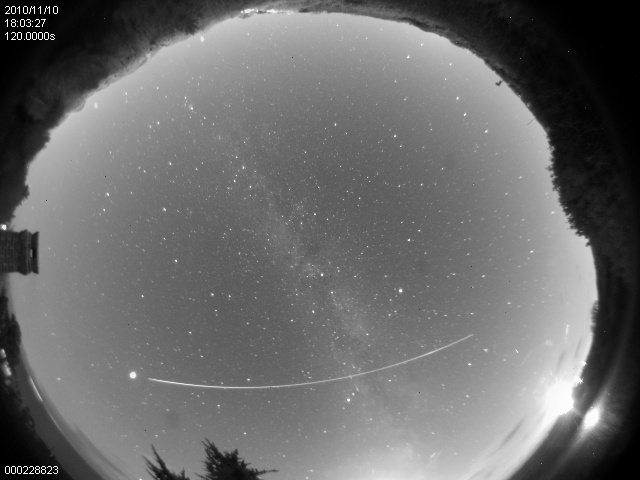
[/caption]
I know I always smile when I see the International Space Station in the night sky, but here the sky itself appears happy, with the ISS crossing the field of view of the Niton All-Sky camera. With a long exposure, a “star trail” forms as the space station moves across the sky. 🙂
The camera is located on the Isle of Wight and operated through the University of Hertfordshire. Check out the camera’s website — there a some great “unusual” images” which include meteors, atmospheric phenomena and even wildlife making an appearance.
Hat tip: Adrian West on Twitter.
Best of Earth from the ISS

The International Space Station has been orbiting the Earth every day for over 10 years, and the astronauts all say their favorite pastime is looking at the Earth. During the past 10 years, the crews have taken some great pictures of our planet, and these images provide a unique look at our world. These are just a few of the spectacular views of Earth from the space station.


